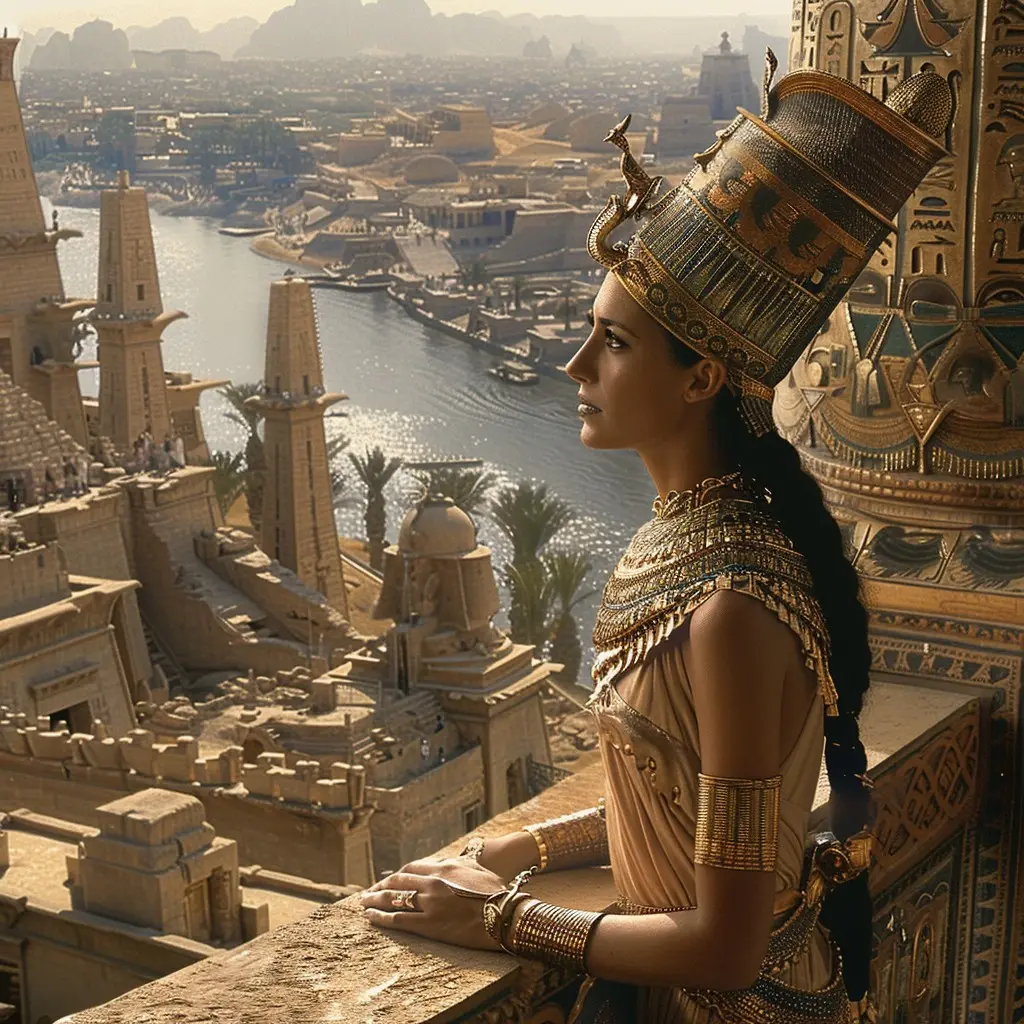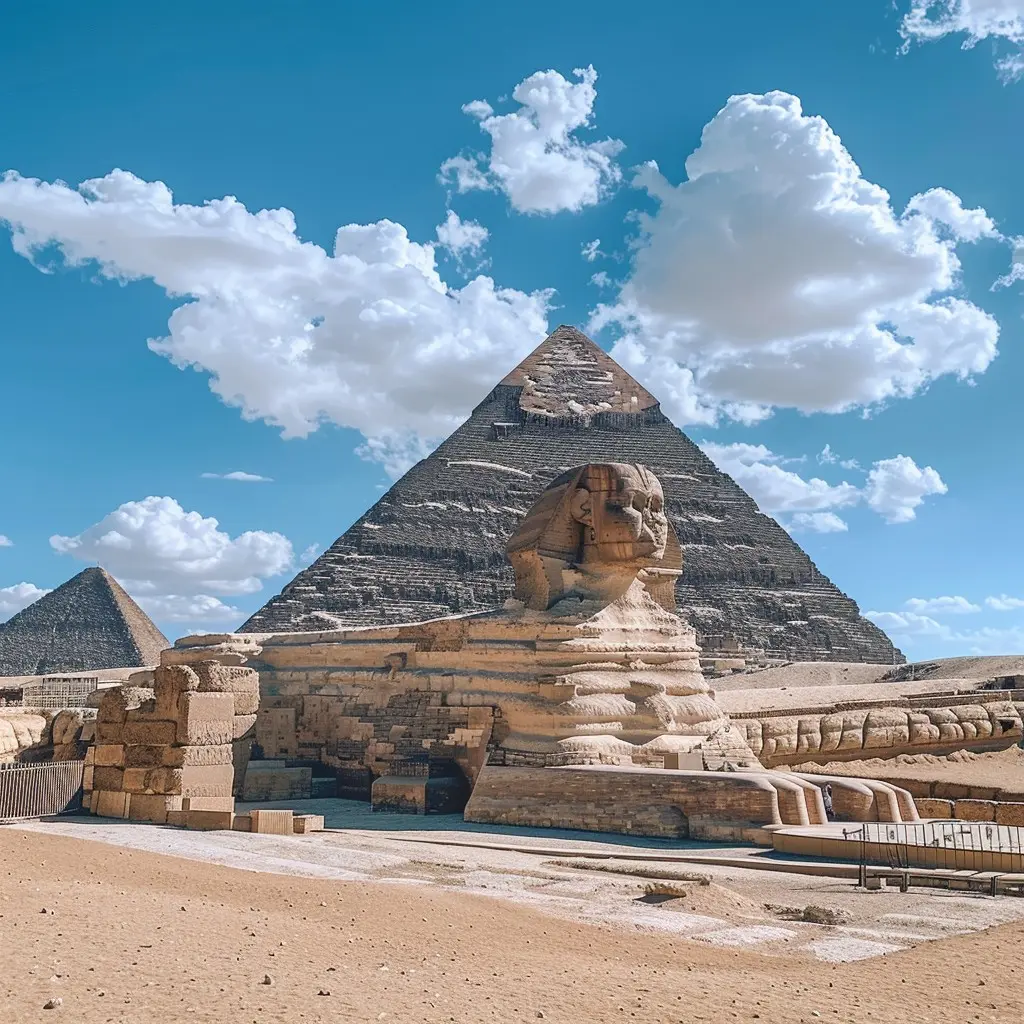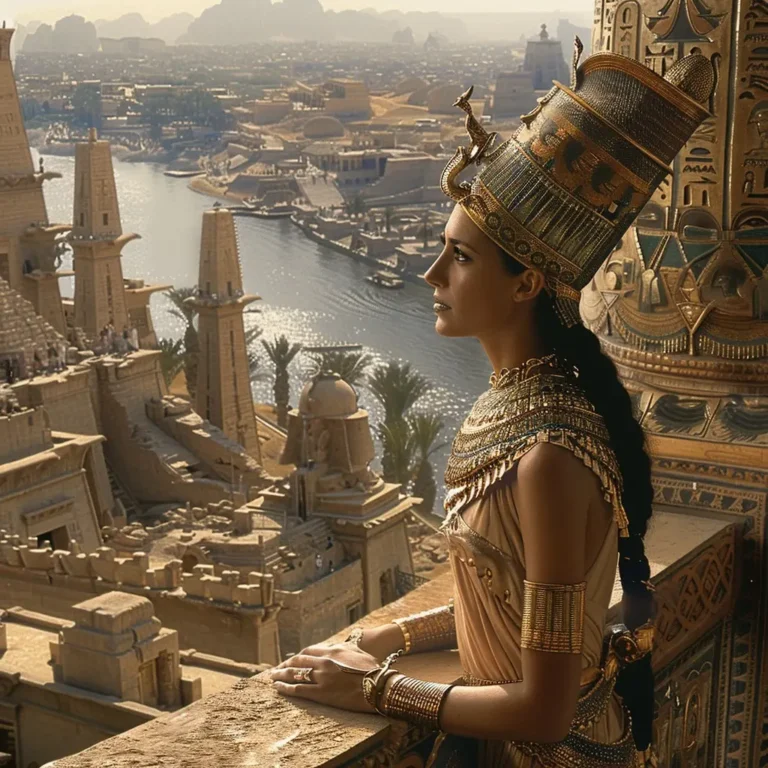Ancient Egypt, with its grand pyramids, enigmatic sphinxes, and rich mythology, has captivated the imagination of historians, archaeologists, and enthusiasts for centuries.
From the monumental achievements of the pharaohs to the intricate beliefs about the afterlife, the civilization’s legacy endures through its remarkable artifacts and timeless stories.
Join us on a journey through time as we uncover 100 incredible facts about this ancient world, exploring everything from their groundbreaking innovations to the secrets buried beneath the sands of time. Get ready to delve into the wonders of ancient Egypt!
Stay sharp and foster your brain health with our Trivia game generator or Fun Facts game for you mental exercises and mental sharpness!

Timeline
The civilization of ancient Egypt began around 3100 BCE and lasted until Alexander the Great’s conquest in 332 BCE.
Dynasties
The history of ancient Egypt is divided into 31 dynasties, grouped into the Old Kingdom, Middle Kingdom, and New Kingdom periods.
Pharaohs
The rulers of ancient Egypt were known as pharaohs, and they were considered both kings and gods.
Pyramids
The most famous pyramids are the three at Giza: the Great Pyramid of Giza, the Pyramid of Khafre, and the Pyramid of Menkaure.
Great Pyramid

The Great Pyramid of Giza is the only surviving wonder of the Seven Wonders of the Ancient World.
Hieroglyphs
Ancient Egyptians used a complex system of writing called hieroglyphs, which included over 700 symbols.
Rosetta Stone
The Rosetta Stone, discovered in 1799, was crucial for deciphering Egyptian hieroglyphs. It contains the same text in Greek, Demotic, and hieroglyphic scripts.
Cleopatra
Cleopatra VII was the last pharaoh of Egypt, known for her relationships with Julius Caesar and Mark Antony.
Mummification
The ancient Egyptians practiced mummification to preserve bodies for the afterlife, involving elaborate rituals and use of preservatives.
Anubis
Anubis, the god of mummification, was often depicted as a jackal or with a jackal’s head.
Osiris
Osiris was the god of the afterlife and the underworld. He was often portrayed as a mummified king.
Pyramids of the Sun and Moon
The first pyramids were built during the Old Kingdom and were called step pyramids, like the Pyramid of Djoser.
Papyrus
Papyrus, made from a reed plant, was used as a writing material and was an early form of paper.
Sphinx
The Great Sphinx of Giza, a limestone statue with a lion’s body and a human head, is believed to represent Pharaoh Khafre.
Tutankhamun
Tutankhamun, often called King Tut, was a pharaoh who became famous due to the discovery of his nearly intact tomb in 1922.
Nile River
The Nile River was crucial to Egyptian agriculture and civilization, providing fertile land in an otherwise desert region.
Scribes
Scribes were highly respected in Egyptian society as they could read and write, and they played a crucial role in administration and record-keeping.
Hatshepsut
Hatshepsut was one of the few female pharaohs and is known for her prosperous reign and extensive building projects.
Cleopatra’s Egypt
Cleopatra VII ruled during the Ptolemaic period, following Alexander the Great’s conquest and the rule of his successors.
Cats
Cats were revered in ancient Egypt, associated with the goddess Bastet, and were often kept as pets.
Mathematics
The ancient Egyptians used mathematics for practical purposes like construction and astronomy. They had an understanding of geometry and algebra.
Medicine
Egyptian medicine included a combination of practical treatments and magical spells. They had advanced knowledge of anatomy and surgery for their time.
Scarabs
Scarab beetles were symbolic in Egyptian culture, representing rebirth and protection. Scarab amulets were commonly worn for luck.
Amulets
Egyptians used amulets as protective charms, often shaped like animals or deities, and worn around the neck or placed in tombs.
Sun God Ra
Ra, the sun god, was one of the most important deities. He was often depicted with a falcon head and a solar disk.
Bastet
Bastet was the goddess of home, fertility, and childbirth, and was often depicted as a lioness or a woman with a lioness’s head.
Temple Rituals
Temples in ancient Egypt were centers of worship and economic activity. Priests performed daily rituals to honor the gods.
Nefertiti
Nefertiti, wife of Pharaoh Akhenaten, is known for her beautiful bust, which is now displayed in Berlin’s Neues Museum.
Maat
Maat was the goddess of truth, justice, and cosmic order. Her concept was central to Egyptian philosophy and ethics.
Wine and Beer
Egyptians brewed beer and made wine, which were staples in their diet. Beer was particularly important for laborers and was often consumed daily.
Death and the Afterlife
Ancient Egyptians believed in an elaborate afterlife where the soul would journey through the underworld and be judged by Osiris.
Book of the Dead
The Book of the Dead is a collection of spells and prayers intended to guide the deceased through the afterlife.
Obelisks
Obelisks were tall, four-sided, narrow monuments with a pyramid-shaped top, originally erected in pairs at the entrances of temples.
Deir el-Bahari
The Temple of Hatshepsut at Deir el-Bahari is renowned for its unique architectural design and terraced layout.
Hieratic Script
In addition to hieroglyphs, Egyptians used a simplified cursive script called hieratic for writing on papyrus.
Demotic Script
Later, they developed Demotic script, which was even more simplified and used for administrative and commercial documents.
Kemet
Ancient Egyptians referred to their land as “Kemet,” meaning “black land,” due to the fertile soil deposited by the Nile.
Hyksos
The Hyksos were a Semitic people who invaded and ruled Egypt during the Second Intermediate Period before being expelled.
Sphinx’s Nose
The Great Sphinx’s nose was famously damaged, possibly due to iconoclasm or erosion. The exact reason remains debated.
Mummified Animals
Egyptians also mummified animals, such as cats, ibis, and bulls, as offerings to the gods or for burial.
Osiris Myth
The myth of Osiris, his death, and resurrection symbolized the cycle of life, death, and rebirth, central to Egyptian religion.
Barge Procession
Pharaohs and deities were often depicted traveling on sacred barges along the Nile, especially during festivals.
Egyptian Calendar
The Egyptian calendar was based on the lunar cycle and the heliacal rising of the star Sirius, marking the beginning of the inundation of the Nile.
Tutankhamun’s Tomb
Tutankhamun’s tomb was discovered in 1922 by Howard Carter, and it was filled with over 5,000 artifacts, including a gold death mask.
Ptolemaic Dynasty
The Ptolemaic Dynasty was founded by Ptolemy I Soter, a general of Alexander the Great. It ruled Egypt until the Roman conquest.
Cairo
Cairo, the modern capital of Egypt, is located near the ancient city of Memphis, which was the capital during the Old Kingdom.
Egyptian Cuisine
Ancient Egyptian cuisine included bread, beer, onions, garlic, fish, and meat, often seasoned with herbs and spices.
Sculpture and Art
Egyptian art was highly stylized, with rigid conventions for how deities and pharaohs were depicted, often showing them in profile.
Sphinx’s Riddles
The Great Sphinx was said to pose riddles to travelers in mythological stories, challenging them to answer or face dire consequences.
Horus
Horus, the falcon-headed god, was associated with the sky and kingship. Pharaohs were often considered his earthly embodiment.
Maat Weighing
In the afterlife, the heart of the deceased was weighed against the feather of Maat to determine their worthiness for the afterlife.
Pyramid Construction
The construction of pyramids involved a large workforce, including skilled laborers and seasonal workers, not slaves as once believed.
Sphinx of Memphis
Besides the Great Sphinx, other sphinx statues were erected, such as the Sphinx of Memphis, which is a colossal limestone statue.
Pyramid of Djoser
The Pyramid of Djoser at Saqqara is considered the earliest large-scale cut-stone construction, marking a major architectural advancement.
Amarna Period
During the Amarna Period, Pharaoh Akhenaten introduced a form of monotheism centered on the sun disk Aten, which was later abandoned.
Egyptian Social Structure
Egyptian society was hierarchical, with the pharaoh at the top, followed by nobles, priests, scribes, artisans, and farmers.
Bubastis
Bubastis (modern-day Tell Basta) was a major center of worship for the goddess Bastet and known for its large temple and sacred cat cemetery.
Ushabti Figures
Ushabti figures were small statues placed in tombs to perform labor for the deceased in the afterlife.
Flood Season
The annual inundation of the Nile was a crucial event for agriculture, bringing fertile silt to the land.
Cartouches
Cartouches were oval-shaped hieroglyphic symbols used to enclose the names of royalty.
Eye of Horus
The Eye of Horus was a symbol of protection, health, and restoration, often used as an amulet.
Pyramid Texts
Pyramid Texts are the oldest religious texts in the world, inscribed on the walls of pyramids during the Old Kingdom.
Daughters of the Pharaoh
Pharaohs often had many daughters, who could hold significant political and religious roles.
Valley of the Kings
The Valley of the Kings is a burial site for pharaohs and powerful nobles of the New Kingdom, located on the west bank of the Nile.
Tutankhamun’s Curse
The so-called “Curse of the Pharaohs” refers to the supposed misfortunes befalling those who disturbed the tomb of Tutankhamun, though this is considered a myth.
Saqqara
Saqqara is a vast necropolis serving as the burial site for the ancient capital, Memphis, and is home to the Step Pyramid of Djoser.
Akhenaten
Akhenaten, also known as Amenhotep IV, attempted to shift Egypt’s religion from polytheism to monotheism centered on the sun disk Aten.
Obelisk Construction
Obelisks were carved from a single piece of stone and transported to their locations using complex techniques.
Sphinx and Pharaohs
The Great Sphinx is believed to represent Pharaoh Khafre, whose pyramid is nearby.
Ra’s Journey
Ra’s daily journey across the sky in his solar barque symbolized the cycle of day and night.
Hieroglyphic Key
The Rosetta Stone provided the key to deciphering Egyptian hieroglyphs by comparing them with Greek and Demotic scripts.
Heliopolis
Heliopolis was a major religious center in ancient Egypt, dedicated to the worship of the sun god Ra.
Ba and Ka
In Egyptian religion, the soul was thought to have multiple components, including the ba (personality) and ka (life force).
Sphinxes and Temples
Sphinxes were often placed in front of temples as guardians and were aligned to protect sacred spaces.
The First Intermediate Period
The First Intermediate Period was a time of political fragmentation and chaos between the Old and Middle Kingdoms.
Cleopatra’s Library
Cleopatra was known for her patronage of the Library of Alexandria, a major center of learning in the ancient world.
Hieratic vs. Demotic
Hieratic script was used for religious and literary texts, while Demotic script was more common for everyday writing and administration.
Egyptian Chariots
Chariots were introduced to Egypt during the Second Intermediate Period and became important in military and ceremonial contexts.
Thutmose III
Thutmose III was one of Egypt’s greatest military pharaohs, expanding Egypt’s empire through numerous successful campaigns.
Papyrus Boats
Papyrus was not only used for writing but also for making boats, which were essential for travel and trade along the Nile.
Ramses II
Ramses II, also known as Ramses the Great, was one of Egypt’s most powerful and influential pharaohs, known for his extensive building projects and military victories.
The Ishtar Gate
Though not Egyptian, the Ishtar Gate of Babylon’s influence can be seen in Egypt’s own monumental architecture, showcasing the interconnected nature of ancient civilizations.
Ancient Egyptian Music
Ancient Egyptian music played a significant role in religious ceremonies and was performed using instruments such as harps, lyres, and flutes.
Osiris’ Symbol
The crook and flail, symbols of kingship and authority, were associated with Osiris and were often depicted in the hands of pharaohs.
Sed Festival
The Sed Festival was a significant ritual celebration marking the continued reign of a pharaoh, involving various ceremonies and athletic competitions.
Aten
Aten, represented as a solar disk, was worshipped during the Amarna Period, reflecting Akhenaten’s attempt to promote monotheism.
Sphinx of Hatshepsut
A notable statue of Hatshepsut, the female pharaoh, depicts her as a sphinx, symbolizing her strength and divine nature.
Osiris’ Judgement
Osiris judged the souls of the dead, determining their fate in the afterlife based on their earthly deeds.
Thebes
Thebes (modern Luxor) was a major city in ancient Egypt and served as a capital during the New Kingdom.
Heliacal Rising
The heliacal rising of Sirius marked the beginning of the flooding season of the Nile, crucial for agriculture.
Nile’s Inundation
The inundation of the Nile was essential for agriculture, providing fertile silt to the fields and ensuring crop growth.
The Weighing of the Heart
In the afterlife, the deceased’s heart was weighed against the feather of Maat to determine their moral integrity and suitability for the afterlife.
The Amulet of Ankh
The ankh symbol represented life and immortality, and it was commonly worn as an amulet for protection.
Canopic Jars
Canopic jars were used to store the internal organs of mummies, which were removed during the mummification process.
The Great Temple of Karnak
The Great Temple of Karnak, located in Luxor, is one of the largest religious complexes in the world and was dedicated to the god Amun.
Scarab Amulets
Scarab amulets were believed to protect against evil and bring good fortune, and were commonly worn or placed in tombs.
The Ba and Ka
The ba was the aspect of the soul that could leave the tomb and return, while the ka was the life force that needed sustenance to survive in the afterlife.
Pharaoh’s Regalia
The pharaoh’s regalia included symbols like the crook and flail, and the double crown, which represented the unification of Upper and Lower Egypt.
Thutmose IV
Thutmose IV is known for the Dream Stele, which recounts his divine right to rule, claimed through a vision of the Sphinx.
Egyptian Education
Education was primarily the domain of the wealthy and included instruction in reading, writing, and religious practices.
Cleopatra’s Coins
Cleopatra VII issued coins with her image and that of her son, which were used to promote her rule and alliances.
Rosetta Stone Inscription
The Rosetta Stone inscription details a decree issued in 196 BCE, celebrating the royal cult of Ptolemy V.
Atenism
Atenism was the religious movement introduced by Akhenaten that focused on the worship of Aten, the sun disk.
Ancient Egyptian Colors
Colors like green (symbolizing fertility), red (symbolizing chaos), and blue (symbolizing the sky and fertility) were significant in Egyptian art and symbolism.
The Old Kingdom
The Old Kingdom, known as the “Age of the Pyramids,” was marked by the construction of the great pyramids and the consolidation of pharaonic power.
The Middle Kingdom
The Middle Kingdom is noted for its advances in art, literature, and monumental construction, and a more stable political structure.
The New Kingdom
The New Kingdom was a period of imperial expansion and prosperity, marked by famous pharaohs like Ramses II and Tutankhamun.
Egyptian Beads
Beads were a popular form of jewelry and were used both for adornment and in burial practices.
Amulets of Protection
Various amulets were worn for protection, including those depicting gods, animals, and symbolic objects.
Egyptian Jewelry
Egyptian jewelry was often elaborate, made from materials like gold, silver, and semi-precious stones, and served both aesthetic and protective purposes.
The Ankh Symbol
The ankh, a cross with a loop at the top, symbolized life and was a common motif in Egyptian art and decoration.
Hieroglyphic Numbers
Egyptians used a system of hieroglyphic symbols for numbers, including symbols for units, tens, hundreds, and thousands.
The Abusir Papyri
The Abusir Papyri are a collection of administrative documents from the Old Kingdom, providing insight into the workings of the ancient Egyptian state.
Tutankhamun’s Curse
The so-called “Curse of the Pharaohs” refers to the alleged misfortunes that befell those who disturbed Tutankhamun’s tomb, though it’s considered a myth.
The Mummification Process
The mummification process involved removing internal organs, desiccating the body with natron, and wrapping it in linen.
Temples as Economic Centers
Temples served as economic centers in addition to religious institutions, managing large estates and resources.
The Role of Women
Women in ancient Egypt had various rights, including property ownership and legal status, although their roles were generally secondary to men.
The Hyksos Period
The Hyksos were foreign rulers who controlled parts of Egypt during the Second Intermediate Period, introducing new technologies like the horse-drawn chariot.
The Book of Caverns
The Book of Caverns is a funerary text that depicts the journey of the deceased through the underworld and their eventual rebirth.
The Role of the Pharaoh
The pharaoh was seen as the living god, responsible for maintaining maat (order) and acting as the intermediary between gods and humans.
The Temple of Philae
The Temple of Philae, dedicated to the goddess Isis, was relocated to Agilkia Island to preserve it from the flooding of Lake Nasser.
Sphinxes in the Temple of Karnak
Sphinx statues were commonly used as guardian figures at the entrances of important temples, including those at Karnak.
The Role of the Pharaoh in Warfare
Pharaohs often led military campaigns and were depicted as victorious warriors in art and inscriptions.
The Egyptian Concept of Time
Egyptians had a unique concept of time that included a civil calendar of 12 months and a lunar calendar used for religious purposes.
Egyptian Burial Practices
Egyptian burial practices involved elaborate rituals, including the use of canopic jars, grave goods, and the mummification of the deceased.
The Role of the Nile in Religion
The Nile was considered a divine gift from the gods and played a central role in religious rituals and mythology.
Ancient Egyptian Sculpture
Egyptian sculpture was highly stylized and adhered to strict conventions, with figures often depicted in profile or frontal view.
The Amarna Letters
The Amarna Letters are diplomatic correspondences on clay tablets from the Amarna Period, providing insight into international relations.
The Role of the Pharaoh’s Wife
The pharaoh’s wife, often a queen consort, held significant status and could be involved in political and religious activities.
The Egyptian Ptolemies
The Ptolemaic dynasty ruled Egypt following Alexander the Great’s conquest and included notable figures like Cleopatra VII.
Ancient Egyptian Calendars
Egyptians used both a lunar and a solar calendar, with their solar calendar being based on the annual flooding of the Nile.
Egyptian Shipbuilding
The Egyptians were skilled shipbuilders and used various types of boats for transportation, trade, and religious ceremonies.
The Sphinx of Giza
The Great Sphinx of Giza is one of the most iconic symbols of ancient Egypt, believed to represent the pharaoh Khafre.
Ancient Egyptian Music
Music played a significant role in religious ceremonies and daily life, with instruments such as harps, lyres, and flutes being commonly used.
The Valley of the Queens
The Valley of the Queens is the burial site for the wives of pharaohs and other royal family members, located near the Valley of the Kings.
Egyptian Burial Chambers
Burial chambers in tombs were often richly decorated with scenes of daily life, religious texts, and protective spells.
The Aten Cult
The Aten Cult was an attempt by Pharaoh Akhenaten to replace traditional polytheistic worship with the worship of the sun disk Aten.
Ancient Egyptian Astronomy
Egyptians had a deep understanding of astronomy and used it to create their calendar and align their monuments.
The Role of Scribes
Scribes were highly respected professionals responsible for writing, record-keeping, and managing administrative tasks.
Egyptian Architecture
Ancient Egyptian architecture included impressive structures such as temples, pyramids, and obelisks, showcasing advanced engineering skills.
The Role of Animals in Religion
Animals played significant roles in Egyptian religion, with many deities being depicted as animals or having animal characteristics.
The Significance of Rituals
Rituals were an essential part of Egyptian religion and daily life, including offerings, prayers, and ceremonies to honor the gods.
The Egyptian Book of the Dead
The Book of the Dead is a compilation of spells and instructions meant to guide the deceased through the afterlife.
Egyptian Law
Egyptian law was based on principles of justice and order, with a system of courts and officials to administer and enforce legal matters.
The Role of Festivals
Festivals were important in Egyptian culture, celebrating religious events, deities, and seasonal changes with processions, offerings, and feasts.
The Structure of Egyptian Society
Egyptian society was hierarchical, with the pharaoh at the top, followed by nobles, priests, scribes, artisans, and farmers.
Egyptian Symbolism
Symbols like the ankh, scarab, and Eye of Horus had deep religious and cultural meanings and were used in art, jewelry, and amulets.
The Significance of the Afterlife
The belief in an afterlife was central to Egyptian religion, with elaborate preparations made to ensure a successful journey to the next world.
Egyptian Trade
Egypt engaged in extensive trade with neighboring regions, exchanging goods such as gold, papyrus, and textiles for resources like cedarwood and incense.
The Role of Magic
Magic was an integral part of Egyptian religion and daily life, used for protection, healing, and invoking divine favor.
Egyptian Writing Materials
Papyrus was the primary writing material, while ostraca (pottery shards) were used for less formal writing and recording.
The Importance of Agriculture
Agriculture was the backbone of ancient Egyptian society, with the Nile’s annual flooding providing fertile soil for crops.
The Pharaoh’s Tomb
The construction of elaborate tombs for pharaohs was a significant aspect of Egyptian funerary practices, reflecting their status and preparing for the afterlife.
The Legacy of Ancient Egypt
The legacy of ancient Egypt continues to influence modern culture, art, and architecture, with its monuments and artifacts being key to understanding its history.
The Role of the Nile in Daily Life
The Nile River was central to daily life in ancient Egypt, providing water, transportation, and fertile land for agriculture.
The Influence of Egyptian Art
Egyptian art was characterized by its adherence to strict conventions and was used to convey religious and political messages.
The Importance of Religion
Religion was central to every aspect of Egyptian life, influencing their beliefs, practices, and understanding of the world.
The Role of Temples
Temples were not only religious centers but also economic hubs, managing vast estates and resources for the gods and pharaohs.
The Legacy of the Pyramids
The pyramids of Egypt continue to be a symbol of ancient ingenuity and architectural prowess, attracting interest and study worldwide.
The Diversity of Egyptian Deities
Ancient Egyptian religion included a diverse pantheon of deities, each with specific roles, attributes, and associations.
The Role of Rituals in Daily Life
Rituals were performed daily in temples and homes to maintain harmony with the gods and ensure the well-being of individuals and the community.
Egyptian Artifacts
Artifacts from ancient Egypt, such as statues, jewelry, and pottery, provide valuable insights into their culture, religion, and daily life.
The Pharaoh’s Divine Status
The pharaoh was considered a divine ruler, representing the gods on earth and maintaining cosmic order and stability.
The Significance of Sacred Animals
Sacred animals, such as cats, ibis, and crocodiles, were associated with various deities and held religious significance in Egyptian culture.
The Impact of Alexander the Great
Alexander the Great’s conquest of Egypt marked the beginning of the Hellenistic period, influencing Egyptian culture and politics.
The Role of Astronomy
Astronomy played a crucial role in ancient Egyptian religion and architecture, with the alignment of temples and pyramids often reflecting astronomical events.
The Influence of Egyptian Culture
Egyptian culture, art, and religion have had a lasting impact on subsequent civilizations and continue to be a source of fascination and study.
Reference
https://en.wikipedia.org/wiki/Ancient_Egypthttps://www.bbc.co.uk/bitesize/articles/zsdpp4jhttps://www.livescience.com/55578-egyptian-civilization.htmlhttps://www.britannica.com/place/ancient-Egypthttps://kids.nationalgeographic.com/history/article/ancient-egypt





